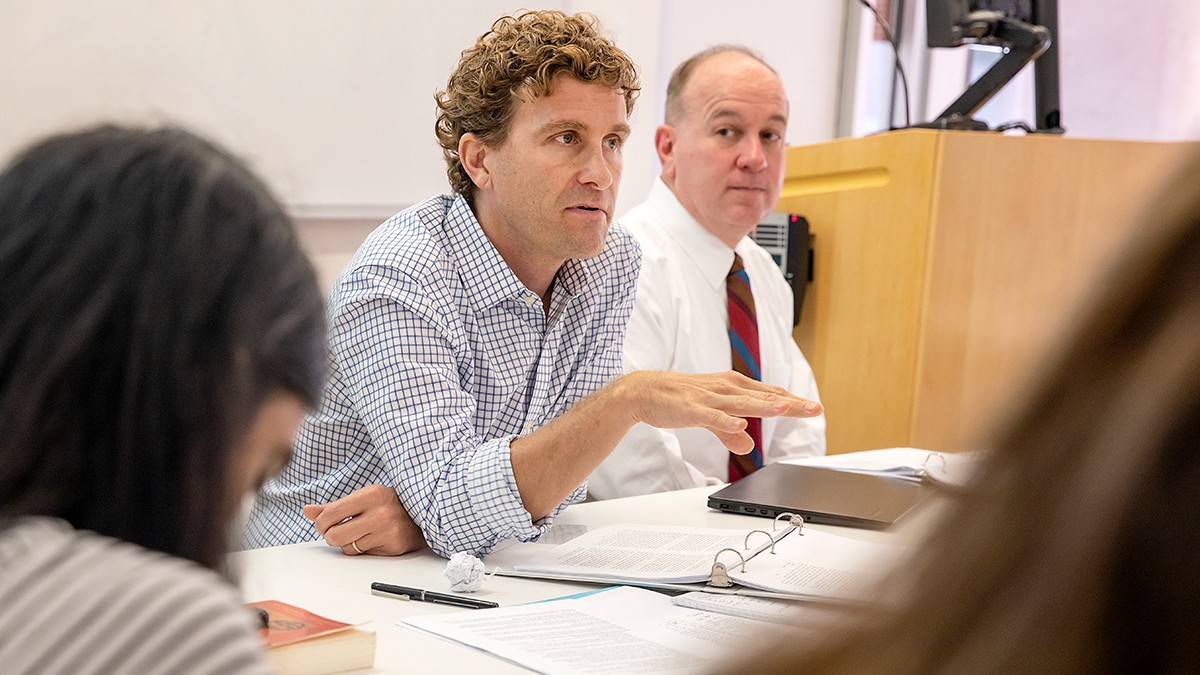‘Unlikely’ subject pairings lead to deep learning at Carolina
Time and the Medieval Cosmos, a new course in the College of Arts & Sciences, challenges students to explore the sciences and the humanities together.

An astrophysicist and a religious historian walk into a classroom. They decide to teach a course together.
There’s no punchline — that’s just Carolina.
This semester, the two professors from seemingly unconnected fields have teamed up to teach “Time and the Medieval Cosmos” as part of the Integrated Curricula, a program within the University’s Quality Enhancement Plan. The new course covers the relationship between science and religion, and the ways that cultural norms influence which scientific models “win out” or persist.
Teaching the mathematical models of the solar system alongside Christianity in the Middle Ages might seem like an unusual pairing, but the disciplines have a lot to learn from each other, according to professors Chris Clemens and Brett Whalen.
“It’s really great to look at the history of science to see that people back in the Middle Ages were wrestling with incredible scientific questions, even if they framed them differently and were thinking more about them in terms of theology,” said Whalen, an associate history professor who studies Christianity during the High Middle Ages.
For example, Clemens said, early scientists used the cycles of the moon and sun to determine the date of Easter, so he taught students an ancient method for calculating the phase of the moon on any given date of any year using only their left hand.
“I’m still astonished at how captivated students are by being able to do a simple calculation on their hand,” said Clemens, the senior associate dean for the natural sciences in the College. “The idea that a person from 800 had an intellectual skill that we don’t possess today is counter-cultural. It’s humbling and eye-opening to know that an illiterate person could do a calculation that you have to learn in order to catch up, and all of this was taught and disseminated by a church.”
“I had my family over for dinner, and I showed them,” Whalen said. “It’s like a magic trick.”
“You are the human calculator,” Clemens said.
“Yeah. And if I had just looked it up on Google, no one cares.”
The course, Whalen and Clemens said, was designed to challenge students to think critically about a subject from many points of view. For first-year computer science student Jacob Hart, that has been the most exciting challenge — putting himself in the shoes of an ancient Christian, trying to fit new scientific discoveries into a framework of faith.
“It’s given me a greater appreciation for historical intellectuals,” he said. “Nowadays we think of things like gravity or inertia as concepts that you’re taught in elementary school, but imagine proving to the entire world that an empirical truth that went against their preconceptions was, in fact, reality.”
For the two professors, the class has been equal parts teaching students and learning themselves.
“Being in this class has been transforming the way I understand historical material,” Whalen said. “I’m the professor, and I’m having my mind blown. I feel like I’ve gone back to school, honestly, and I’ve been immensely enjoying that.”
The professors’ co-teaching approach has inspired students to engage more deeply with the material than ever before, Hart said.
“There’s this sense of wonder that everybody has in the class,” he said. “Professor Whalen is learning about math from Professor Clemens, and Professor Clemens is learning from Professor Whalen, so it feels like they’re also participating in the class at the same capacity as the students are. The discussions and the atmosphere are really fantastic.”
Whalen and Clemens said teaching the course has motivated them to continue taking an interdisciplinary approach to teaching, both to broaden students’ mindsets and to challenge the idea that the sciences and the humanities are best explored separately.
“I think there is a stereotype for some people — an impression — that the relationship between the humanities and the sciences is some zero-sum game, and it’s not,” Whalen said. “People in STEM and people in the humanities have a lot in common. So, I think it’s really great on that level just to see history and physics in dialogue with each other.”




